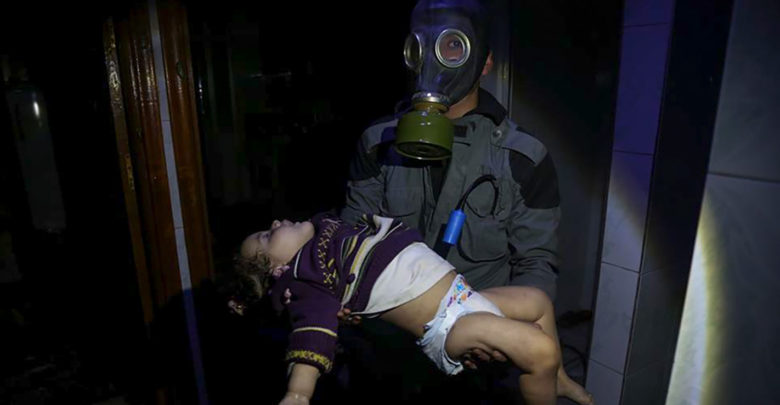
Maria Jellinek
King’s College London
On April 13, the United States and its allies launched a wave of missile strikes in Syria in response to the chemical weapons attack in a Damascus suburb earlier this month. Most international lawyers agree that the intervention was a clear violation of the United Nations Charter. Irrespective of how just one considers the intervention, international law doesn’t allow the use of military force for human protection purposes without U.N. Security Council approval.
Global analysts have been raging about the lack of authorisation – warning that that the U.S. readiness to bypass the Security Council risks destabilising the international legal order. But while the lack of legality is an important conversation to have, the narrow focus on the issue of law overlooks a more pressing question: How ought the international community react when civilians are being massacred with impunity?
The Responsibility to Protect (R2P) norm was meant to solve this query. Agreed to in 2005, the norm mandates that all states have a responsibility to protect their citizens from mass atrocity crimes and when they fail to do so, the international community has a residual responsibility to protect civilians in their place. The norm entrepreneurs behind the conceptualisation of R2P intended for the use of unilateral force to be part of its agenda.
Indeed, in their final report the International Commission on Intervention and State Sovereignty explained that it would be unrealistic to expect states not to proceed unilaterally if the Security Council failed to authorise missions aimed at stopping mass atrocity crimes.
Yet, when the norm was up for discussion at the General Assembly in 2005, many states were unwilling to accept such permissive framework. The final version of R2P eventually agreed upon therefore required all interventions to pass through the Security Council. The global commitment to a collective duty to protect civilians was nevertheless seen as a great step forward, creating a sense of optimism that the Security Council would be more willing to take decisive actions in the future.
It’s not difficult to see how R2P applies in Syria. With an estimated 400,000 civilians killed since the inception of the conflict and a leader who’s committing war crimes and crimes against humanity – the recent use of chemical weapons being one of them – the R2P threshold has clearly been met, calling on the international community to stop the bloodshed.
However, despite the gravity of the humanitarian catastrophe, the Security Council has been unable to shoulder its duty to protect the Syrian people. Thus, after 13 years in circulation it’s becoming increasingly clear that the politicised decision-making procedure in the Security Council is stopping R2P from being effectively implemented. As the existing procedures enable the permanent members to veto any resolution, one differing voice gains de facto veto over any efficient response aimed at saving civilians from mass atrocity crimes. This procedural set-up has enabled Russia to veto 12 resolutions on Syria in order to protect the Syrian leader from his crimes.
Russia’s persistent exercise of the veto highlights the need to rethink the collective action requirement. Indeed, as the Security Council is failing in its duty to protect human rights, the international community must focus on improving the procedures for authorising coercive measures in the future. It cannot be that we remain stuck in a system that’s forcing us to submit to the strict confines of an archaic power structure simply because we’re afraid of what would happen if we challenge the status quo. This is a dangerously regressive logic which needs to be fought.
The critical point here is that defying the U.N. Charter wouldn’t automatically erode the international order if it’s complemented by an initiative to reform and improve the existing governance structures.
While the complete adoption of a new framework for authorising force might be remote, the international community must start taking progressive steps and develop a moral vision of what the law ought to be when the Security Council is failing in its duties to protect human rights.
The vision should be firmly rooted in ethical reasoning and not – as with the present standards – be a concession to political compromise. The jarring reality is that use of military force will always be controversial, even for the just purpose of saving civilians.
Striving for a regulatory standard that all states agree on would therefore be to set up for failure. To avoid such pitfall, the initiative needs to be a philosophical one aimed at arriving at a well-reasoned ethical framework that makes rejection practically unreasonable, even if not everyone actually accepts it. Only through engaging with ethics can the international community arrive at a standard that’s both morally robust and fully in line with protecting human rights worldwide.
In short, the stalemate in the Security Council throughout the Syrian crisis has brought to the fore the clear dissonance between justice and international law. Indeed, because of the inherently politicized nature of the contemporary standards for authorizing force, Syrians have been robbed of their moral right to protection. As the existing structures for regulating coercive measures are fundamentally flawed we have – at the very least – an intellectual duty to suggest an alternative. To go ahead with “business as usual” wouldn’t only be a missed opportunity for reform – it would also undercut future prospects of helping civilians in need.
 Maria Jellinek is a PhD Candidate at the Department of War Studies, King’s College London. Follow her on Twitter: @maria_jellinek.
Maria Jellinek is a PhD Candidate at the Department of War Studies, King’s College London. Follow her on Twitter: @maria_jellinek.
All views and opinions expressed in this article are those of the author, and do not necessarily reflect the opinions or positions of The Defense Post.
The Defense Post aims to publish a wide range of high-quality opinion and analysis from a diverse array of people – do you want to send us yours? Click here to submit an Op-Ed.










